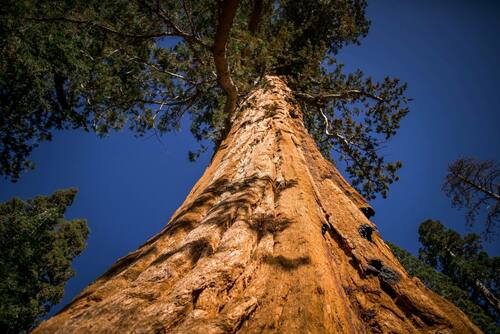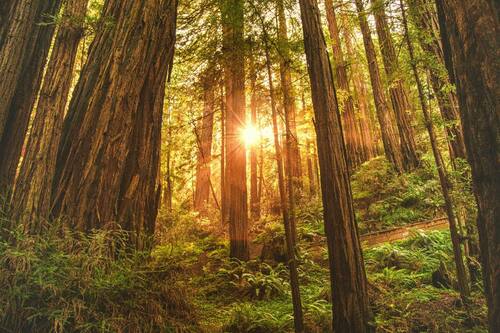Discovering the Resilience and Diversity of California’s Redwoods
The California Redwood: A Tree Like No Other
With the redwood being the state tree of California, Arborist Now definitely has an affinity for these mighty giants. Let’s explore the origins, habitats, and features of these unique trees as well as the adaptations and potential ways we can support them amidst climate change.
Three Different Species of Redwoods: Their Close Relationships and Ancient Origins

A Towering Giant Sequoia – Photo by Sinjin Thomas on Unsplash
There are currently three species of redwoods in the world. Two of these, the coast redwood and the giant sequoia, thrive in California. The third, the dawn redwood, was once believed to be extinct until its rediscovery in western China in the 1940s. These three species, located across California and China, share a close genetic relationship. The redwoods as a species have been on Earth for approximately 130 to 140 million years, underscoring their unique place in our planet’s history.
How Environmental Shifts Have Shaped California’s Redwoods Over Millennia
The giant, ancient redwoods of California have witnessed significant environmental transformations over the ages, including both continental movements and climatic shifts that have profoundly impacted the physical characteristics of today’s redwoods. The two main types of redwoods in California have each adapted to specific ecological niches. The coastal redwood is found just north of the California-Oregon border, extending down to the southern end of Big Sur. This species thrives in the narrow coastal strip that benefits from a moist, cool climate along the western edge of California. Meanwhile, the giant sequoia resides in the Sierra Nevada mountains—a testament to its adaptation to different environmental conditions. These enduring trees provide a living record of how nature adapts to Earth’s ever-changing environment, illustrating the resilience and beauty of California’s native redwoods.
Exploring the Unique Habitat of the Giant Sequoia in the Sierra Nevada

A Human is Dwarfed by Giant Sequoias – Photo by Vitto Sommella on Unsplash
The giant sequoia is a majestic tree found in the Sierra Nevada . It grows in scattered groves in the southern reaches of the Sierra at Sequoia Kings National Park, and also extends north to Calaveras Big Trees State Park as well as into areas south of Lake Tahoe. These forests are surrounded by granite landscapes and provide a magical setting for both casual visits and scientific study. The giant sequoia is adapted to endure the heavy snowfalls of the Sierra Nevada winters, showcasing its resilience and the dynamic nature of its mountainous habitat. This iconic tree captivates those who visit these high-altitude environments, and it not only plays a critical role in the biodiversity and ecological balance of its native region but also benefits the environment as a whole.
The Critical Role of Snowfall and Water Cycles for Giant Sequoias in the Sierra Nevada
Giant sequoias thrive in the Sierra Nevada and receive the high levels of snowfall , which is an essential element for their survival. This abundant snowfall replenishes the groundwater annually, which these towering trees heavily depend on. The deep root systems of giant sequoias are specifically adapted to utilize the water from this snowpack recharge every winter. This unique habitat hydrology is crucial for their existence, and complements their unique physiological traits.
In addition, the summer months can bring warmth and sometimes more intense heat, making the areas prone to wildfires. However, the sequoias have adapted to these conditions too, using their nearly 18-inch-thick spongy bark to protect the interior of the trees from damage, providing burn resistance and insulation from the heat. Click here to learn more about the basic anatomy of a tree and how this structure can protect them from threats such as wildfires, and more. Unfortunately, recent years have seen severe wildfires impact the forests , notably around the Redwood Mountain Grove near Sequoia Kings National Park, where many ancient trees have been lost. This highlights the intertwined relationship between giant sequoias, their mountainous environment, and the changing climate, as well as the importance of protecting these natural giants and their delicate ecosystems.
Adaptations and Environmental Challenges of Coastal Redwoods and Giant Sequoias
Coastal redwoods and giant sequoias exhibit remarkable adaptations that confer resilience against wildfires, although the recent fires have tested the limits of these ancient giants. Coastal redwoods thrive along California’s coast, supported by a temperate climate with minimal temperature fluctuations. This is influenced by the summer coastal fog, which spans from San Diego to Oregon, traveling up to 50 miles inland and providing essential moisture and cooling for the redwoods. This process is integral to their ecology and physiology.
In contrast, giant sequoias reside in the variable montane environments of the Sierra Nevada, where they endure snowy winters and warm summers. These trees rely on the snowpack for water and have developed unique characteristics to thrive under such conditions. Both species have long withstood various environmental changes over millions of years, demonstrating their distinct ecological niches and the ongoing threats that challenge their survival. This interplay between fog and snow highlights the vital ecosystem factors that sustain these majestic trees.
Assisted Migration: A Potential Strategy for Redwood Conservation
Exploring assisted migration as a strategy to address climate change challenges for trees like redwoods has become increasingly popular today. This method involves relocating species to new regions where they are more likely to thrive under shifting climate conditions. Historically, redwoods exhibited greater leaf area, but due to water stress—a consequence of changing climates—they now shed leaves to conserve water. This adaptation highlights the potential need for assisted migration , where redwoods might be moved northward into the Pacific Northwest, including Oregon, where conditions are becoming more favorable.
However, this approach isn’t without its downsides. Introducing redwoods to new areas could disrupt local ecosystems, creating competitive tensions with native conifers already established in Oregon and Washington. Furthermore, experiments in the Southern Hemisphere have explored planting coastal redwoods for carbon sequestration, suggesting a broader application of assisted migration. While private landowners in Oregon have started considering planting redwoods in place of harvested Douglas firs, the broader implications of such shifts—including ecological impacts and the management of new interspecies relationships—must be carefully considered to ensure ecological balance and the long-term viability of redwoods and local species alike.
Conserving Redwoods: Understanding Their Unique Adaptations and Emerging Threats

A Redwood Tree with Moss on its Trunk – Photo by Mike L on Unsplash
Redwoods, with their distinctive adaptations, are marvels of nature, perfectly suited to their environments. Yet, they face significant threats from climate change, wildfires, and human encroachment that jeopardize their survival. Protecting these trees is crucial for the ecological balance and for future generations to enjoy.
The resilience of redwoods outside their typical fog zones also raises concerns. For example, redwoods planted along highways, like those seen on routes up to Santa Rosa, show adaptations such as thinner crowns and reduced leaf areas—indicative of their struggle in less ideal conditions. These observations underscore the importance of conservation efforts and adapting management practices to ensure the longevity of these iconic trees. This highlights the need for ongoing research and protective measures to safeguard redwoods against the changing climate and other environmental pressures.
Commitment to Excellence in Urban Forestry: Arborist Now’s Promise to Our Clients

A Redwood Forest at Sunset – Photo by Billy Huynh on Unsplash
In our journey through the diverse and resilient world of California’s redwoods, we see a reflection of our commitment at Arborist Now to the stewardship of urban forestry. Our dedicated services ensure that the same level of care and attention given to these ancient giants is accessible for the trees in your community or property. We understand the critical role that trees play in our urban landscapes, and we are here to help our clients manage their green spaces with expertise and sustainability in mind. For those who value the health and longevity of their trees, Arborist Now offers professional guidance and solutions. Connect with us today to see how our commitment to excellence in tree care can enhance your environment and contribute to a greener, more sustainable future.



